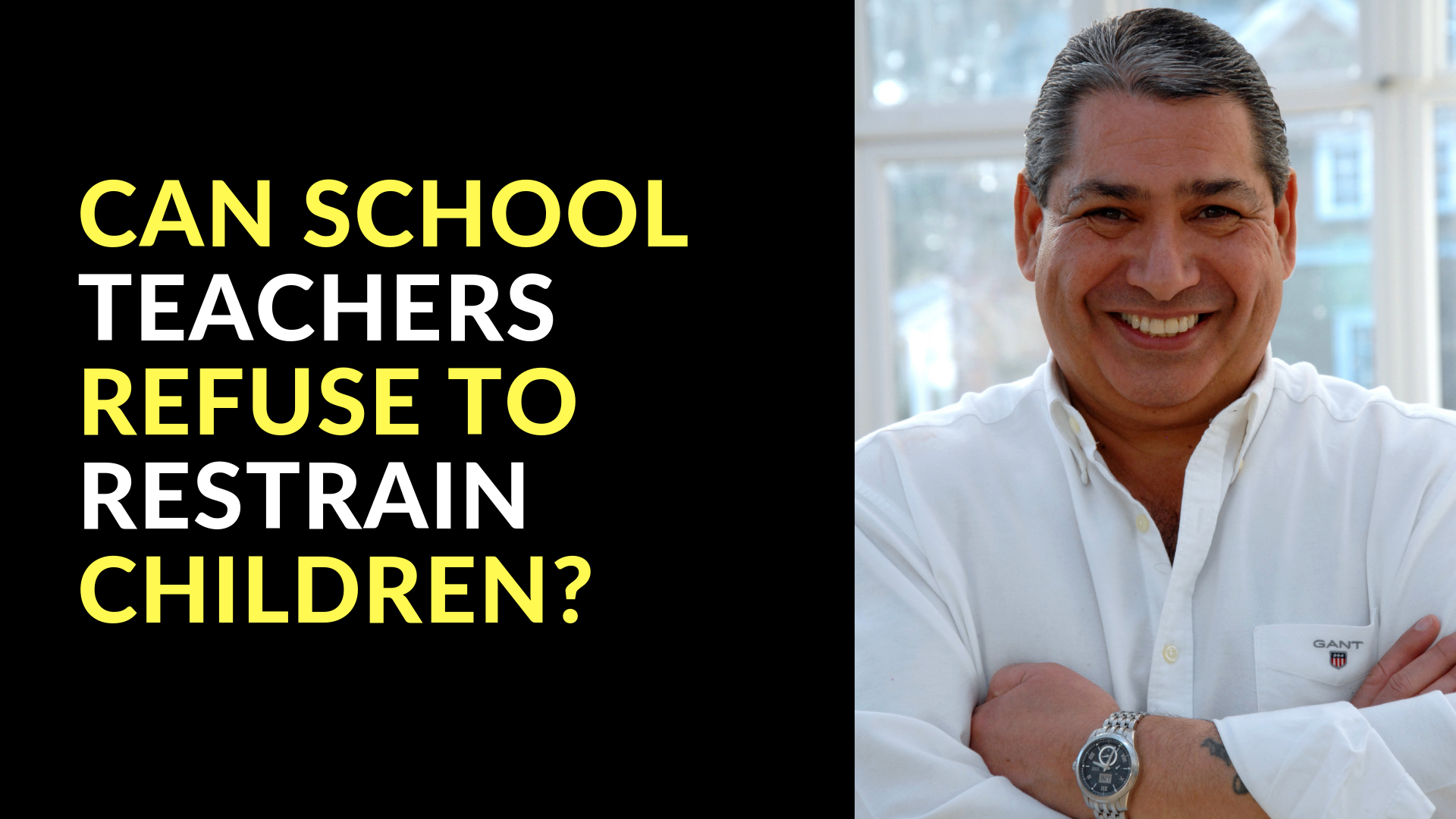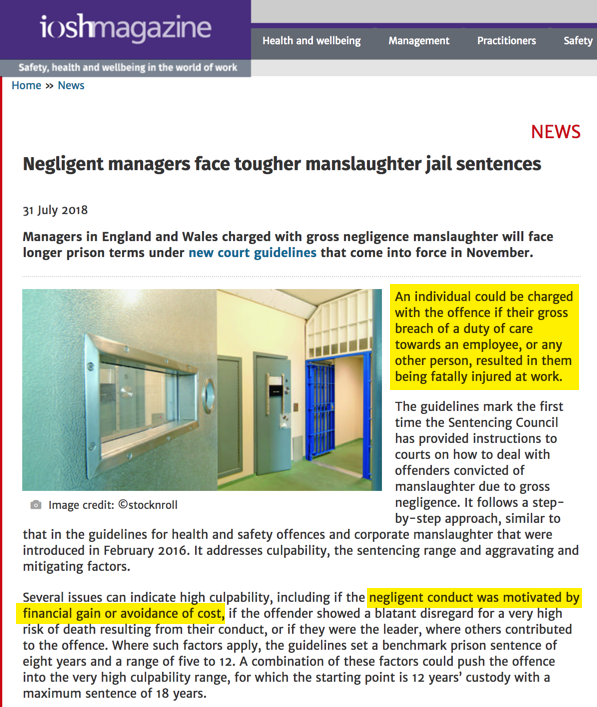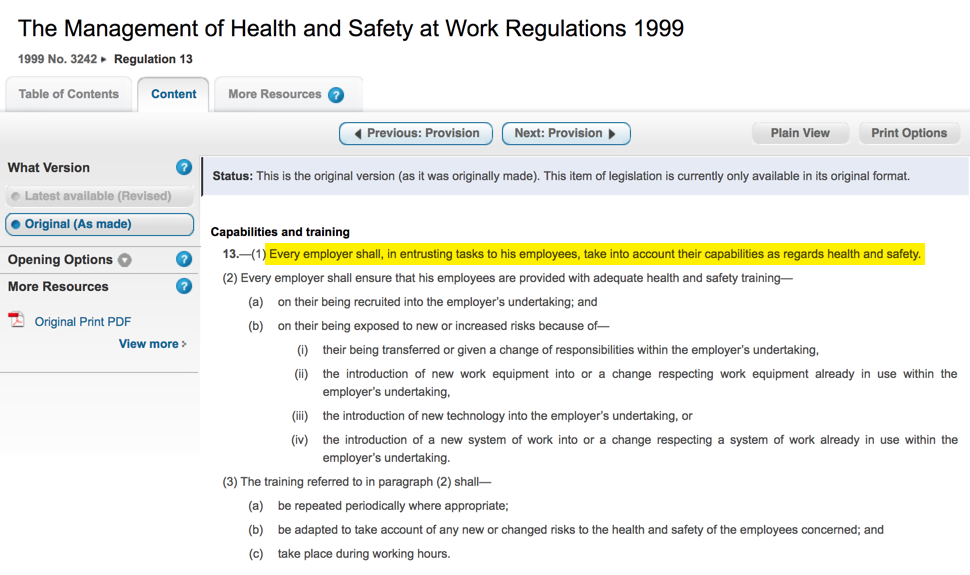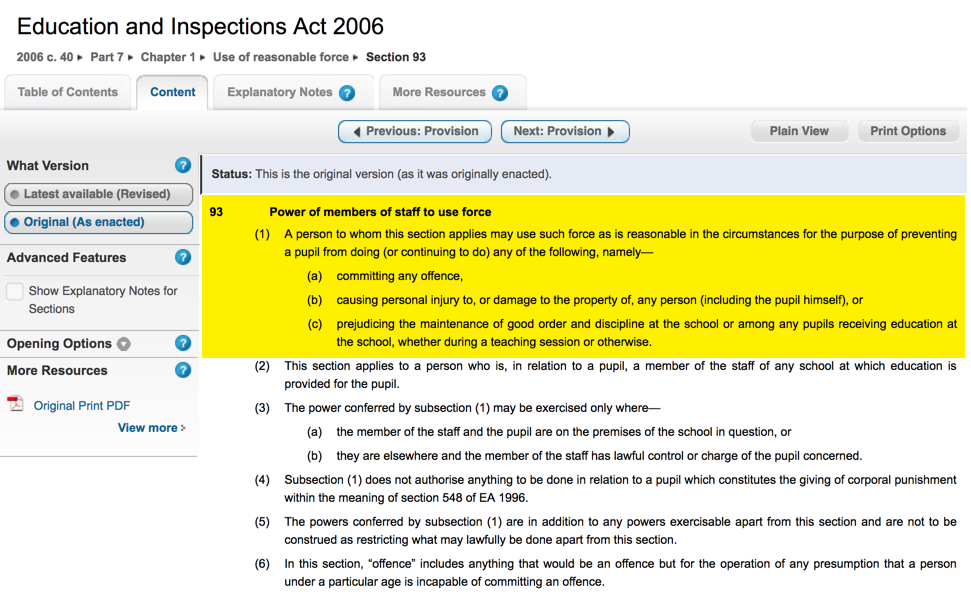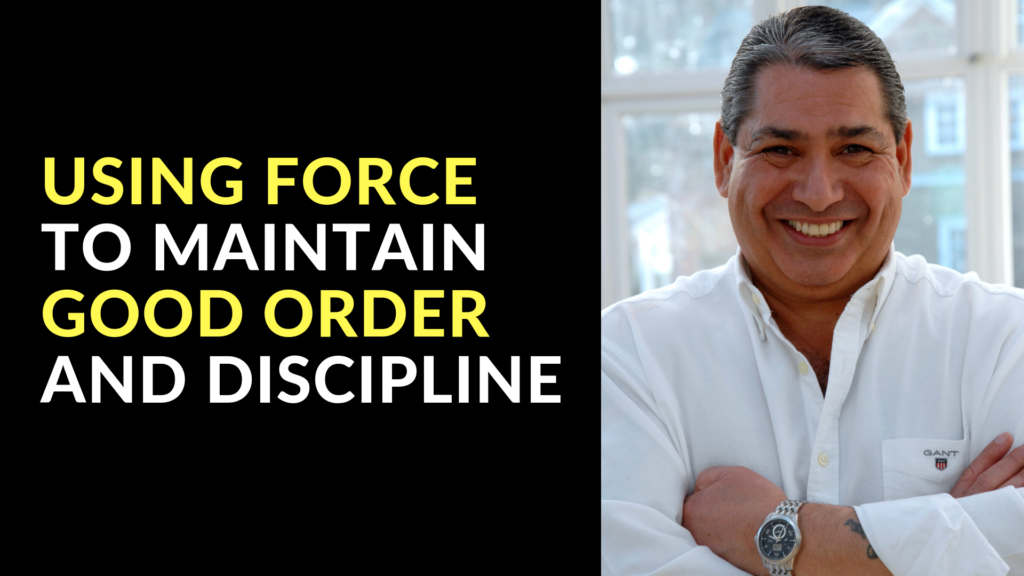Can School Teachers Refuse To Restrain Children?
Can school teachers refuse to restrain children? Let me re-frame the question. If a child or a fellow teacher was seriously injured or died because a teacher made the disastrous mistake of not intervening when they should have done, can you imagine the catastrophic series of events that would follow?
The school and the teacher could be targeted with a lawsuit for negligence, prosecution and even jail sentences.
And with tougher laws and longer jail sentences for managers convicted of gross negligence manslaughter, this is something that all head teachers and chairs of the board of Governors should be aware of, which was highlighted in an IOSH (Institute of Occupational Safety and Health) newsletter in July 2018 (see below).
THE LEGAL RESPONSIBILITIES
The question therefore is ‘can school teachers refuse to restrain children?’
But, before we answer the question fully, let’s look at what the legal responsibilities of teachers are with regards to the duty of care owed to the pupils in their care and also to their colleagues and the vicarious liability of the school as a whole.
A teacher’s legal responsibilities derive from who main sources, which are:
- The common law duty of care, and
- The statutory duty of care.
THE COMMON LAW DUTY OF CARE – ‘IN LOCO PARENTIS’
‘In loco parentis’ means ‘instead of parents’ and has legal significance when it comes to looking after other people’s children.
The term ‘in loco parentis’ was used to describe the duty of care that a teacher has towards a pupil, to the effect that a teacher has a duty to take the same reasonable care of the pupil that a parent would take in those circumstances.
‘In loco parentis’ originally embodied the nineteenth-century common law principle that a teacher’s authority was delegated by a parent so far as it was necessary for the welfare of the child.
In 1893 a court held that “the schoolmaster is bound to take such care of his pupils as a careful father would”.
In 1962 the courts stated that the ‘standard of care’ expected of a teacher was held to be that of a person exhibiting the responsible mental qualities of a prudent parent in the circumstances of school, rather than home life.
When you leave your child at the school gates you are in effect agreeing to allow the teachers and other staff at the school to act ‘in loco parentis’
This means that the school staff have a duty of care towards your child.
THE STATUTORY DUTY OF CARE
There are a number of statutory provisions that highlight the statutory duty of care that teaching staff have to children and each other and the following paragraphs will cover these.
THE CHILDREN ACT 1989
The Children Act 1989 provides that teachers have a duty of care towards the children under their supervision, as well as promoting the safety and welfare of the children in their care.
The level of this duty of care is measured as being that of a ‘reasonable parent.
The Children Act 1989 Section 3(5) further defines the duty of care to the effect that a person with care of a child may do what is reasonable in all the circumstances for the purpose of safeguarding or promoting the welfare of the child.
Under the Act schools (as well as local authorities, academies and colleges) have a statutory duty to carry out their functions with a view to safeguarding and promoting the welfare of children under the Education Act 2002 and accompanying regulations.
This includes taking steps to protect children who are at risk of significant harm, which is further defined in the Children Act as ill-treatment or the impairment of a child’s physical or mental health or of their physical, intellectual, emotional, social or behavioural development.
A BREACH OF THE DUTY OF CARE OWED BY A TEACH TO A CHILD COULD AMOUNT TO NEGLIGENCE
One factor with regards to Whether a teacher can be found negligent will be whether the incident that occurred could have reasonably have been foreseen and another factor is whether the teacher took all reasonable steps to ensure the safety of the pupil/pupils.
A teacher who didn’t intervene when they were trained to do so and it was safe to do so would very likely fall into the above factors.
THE HEALTH & SAFETY AT WORK ACT 1974
The Health and Safety at Work Act 1974 puts a further obligation on the school as a whole to safeguard the health, safety and wellbeing of pupils in its care and also it’s school staff.
The main responsibility under the Health and Safety at Work etc Act 1974 rests with employers, who have to take reasonable care for the health and safety of their employees and others on school premises.
With regards to the physical restraining of children in the schools care, this means that the school must provide adequate information, instruction, training and supervision to its staff to ensure that any restraint is carried out as safely as possible.
In addition, Regulation 13 of the Management of Health and Safety at Work Regulations requires that when entrusting tasks to teaching staff (such as the need to restrain pupils) the management of the school take into account their teaching staff’s capabilities in being able to carry out that specific activity to the required competent standard.
Under Section 7 of the Health & Safety at Work Act, every teacher is required to do all that is reasonable to protect the health, safety and welfare of pupils and their colleagues who may be affected by their acts or omissions at work.
Therefore, to summarise so far:
1: All teaching staff have a common law and statutory obligation with regard to the duty of care owed to the children and their colleagues;
2: If teaching staff are expected to restrain children in their care, the school must provide training to ensure that the teaching staff have the capability and are competent in being able to restrain children in the safest way possible to reduce the risk to the child and the risk to others.
Thus, a teacher who omitted (intentionally refused) to intervene and restrain a child, when it was safe in the circumstances to do so, would be in violation of their common law and statutory duty of care owed to the child and others.
THE EDUCATION & INSPECTIONS ACT 2006
Teachers in both England and Wales have a statutory power to use reasonable force to restrain pupils in a number of circumstances as set out in Section 93 of the Education and Inspections Act 2006.
Section 93 provides teachers with the power to use of reasonable force to prevent pupils from hurting themselves or others, from damaging property, or from ‘prejudicing the maintenance of good order and discipline’.
THE LEGAL DIFFERENCE BETWEEN ‘POWER’ AND ‘DUTY’
Now at this stage let me clarify the difference between have the ‘power’ to do something and having a ‘duty’ to do something.
Having the ‘power’ is not an absolute right. It is a discretionary privilege.
This means that the ‘power to use reasonable force’, as provided by Section 93 of the Education and Inspections Act 2006, is an option a teacher has to use in very limited circumstances as outlined in the Children Act 1989.
A duty in law, however, is different. A ’duty’ is a legal obligation and a breach of a ‘duty’ can result in liability for that breach.
Oh, and by the way, the power to use force to ‘maintain good order and discipline’ as provided by Section 93, in isolation, is illegal, and you can find out more about that by clicking on the image below.
A ‘FAILURE TO RESPOND’
Therefore, if a ‘duty of care’ exists (as it does between a teacher and a pupil and a teacher and other teachers), to (in this example) respond (by exercising their ‘power’ to use reasonable force, to control and restrain a child to prevent harm to the child or others), and a teacher fails to respond which results in harm to the child or others, which would have been negated by the act of responding, then there is a clear breach of the duty of care owed to the child or others by that negligent omission.
This could lead to investigation and prosecution for breaches of various Sections of the Health & Safety at Work Act, breaches of the Children Act, The United Nations Convention on The Rights of The Child and the Human Rights Act, (and this is not an exhaustive list).
If a death was to occur that there would also possibly be grounds for charges of corporate manslaughter against the school and charges of gross negligence manslaughter against the director/senior manager (in this case possibly the headteacher) who may have, by act or omission, allowed the failure to respond to happen.
It would also be a violation of Article 2(1) of the Human Rights Act 1998.
VICARIOUS LIABILITY
Employers have ‘vicarious liability’ for the negligence of their employees at work.
This means broadly that the employer takes responsibility if employees do not properly fulfil their obligations under common and statute law whilst at work.
Therefore, any legal claims will most likely be made against employers, which will be the school as this recent Supreme Court ruling highlights, and you can also find out more about that by clicking on the image below.
SUMMARY
Let’s go back to the main question which is – ‘can school teachers refuse to restrain children? if they are trained to do so, or would the ‘failure to respond’ in the physical restraint of a child be a negligent omission if a child or teacher was seriously injured or killed?’
1: If it is reasonably foreseeable that a teacher may have to physically intervene to protect pupils and/or other staff then they are legally obligated to do so.
2: That means that the school must provide suitable and sufficient information, instruction, training and supervision to its teaching staff to enable them to know when to intervene, when not to intervene and how to intervene as safely as possible, consistent with the duty of care owed to the children and the school staff.
3: A teacher who is subsequently competently trained, and thus has the capability to do so, would be expected to intervene in the required circumstances should the situation/s arise in line with the duty of care they owe to the children in school and to their colleagues.
4: A teacher who failed (omitted) to do so, would be in breach of the duty of care owed by them to the child and their colleagues.
5: Any injury that occurred, to the child or to another teacher, which may not have occurred had the teacher intervened, could result in the teachers’ omission being classed as an act of negligence.
6: The school would also be culpable and may very likely end up being held vicariously liable for their member of staff’s negligent omission if a staff member, who was trained and competent to do so, chose not to intervene, which resulted in harm to a child or a member of school staff.
7: In addition, any such omission could also be classed as a breach of a teacher’s common law duties under ‘in loco parentis’, and statutory duties under the Health & Safety at Work Act 1974, the Children Act 1969, The United Nations Convention on the Rights of The Child and the Human Rights Act 1998.
Deciding to engage in a physical restraint with a child can be an agonising decision for a teacher to make.
Most teachers didn’t join the teaching profession to restrain children and many are frightened of doing so due to the hazardous nature of nature of the activity, which can have a devastating effect on a teacher’s professional career if things go badly wrong.
There is no argument that physical restraint carries inherent risks and trying to restain a child who may be screaming and shouting and wanting to punch you or another child can be a daunting and intimidating task.
The real tragedy is that restraint has to happen at all, but the reality is that it is sometimes needed, and if used correctly and with the right process in place and with the appropriate post-incident support systems for the children and staff in place, it can be a useful tool in managing behaviour that challenges.
However, failure to restrain a child where there is a serious risk of harm would amount to a breach in the duty of care owed to that child and others. It would be an act of negligence.
In many circumstances, it is simply not a safer option for a teacher to do nothing or to take very limited action when taking the appropriate action could restore safety in a safer manner.
If you are a school and you’d like to know more about how we can deliver legally defensible training to your teaching staff and also qualify some of your teachers as trainers, then contact me at [email protected] or fill out our contact us form on our website here – https://nfps.info/contact-nfps/
Also, please watch the video below.

